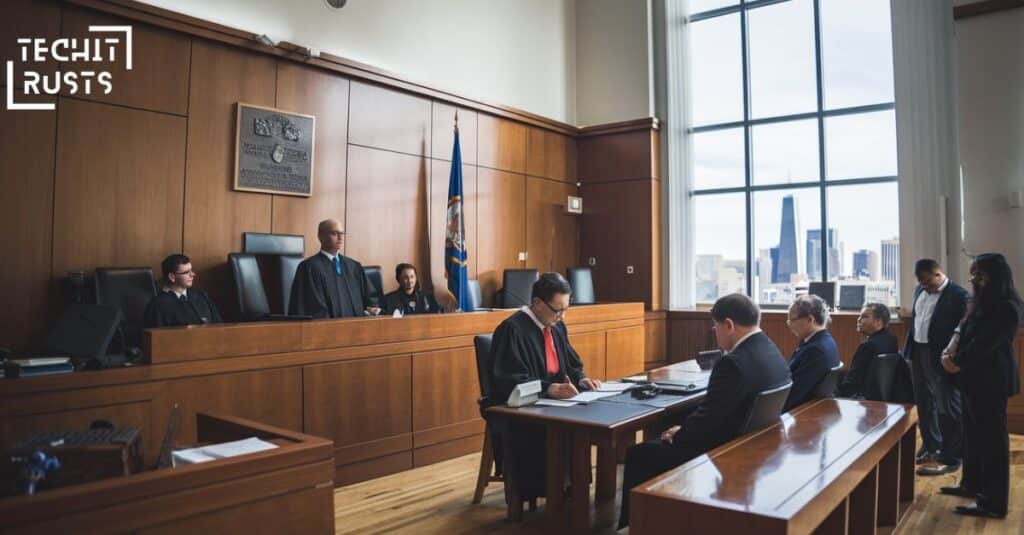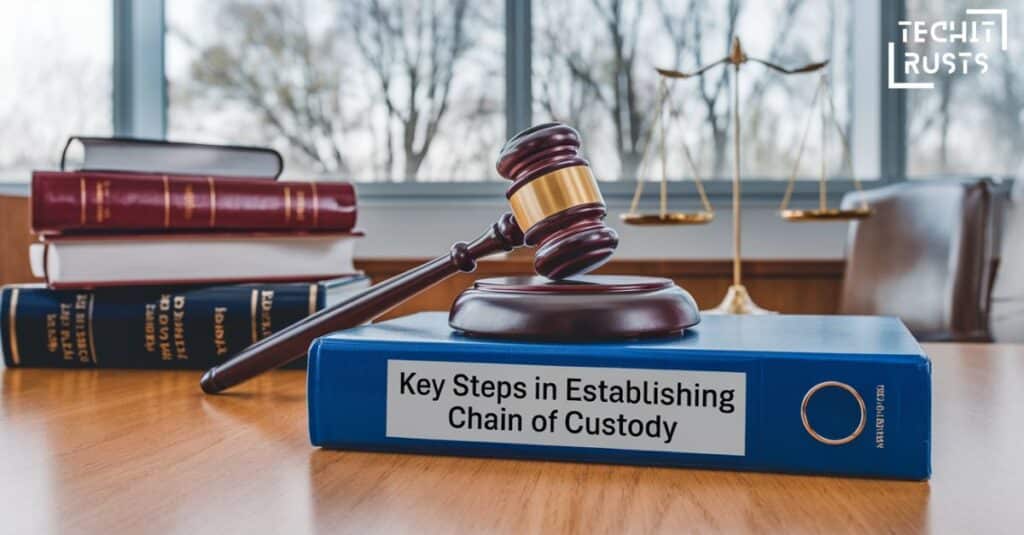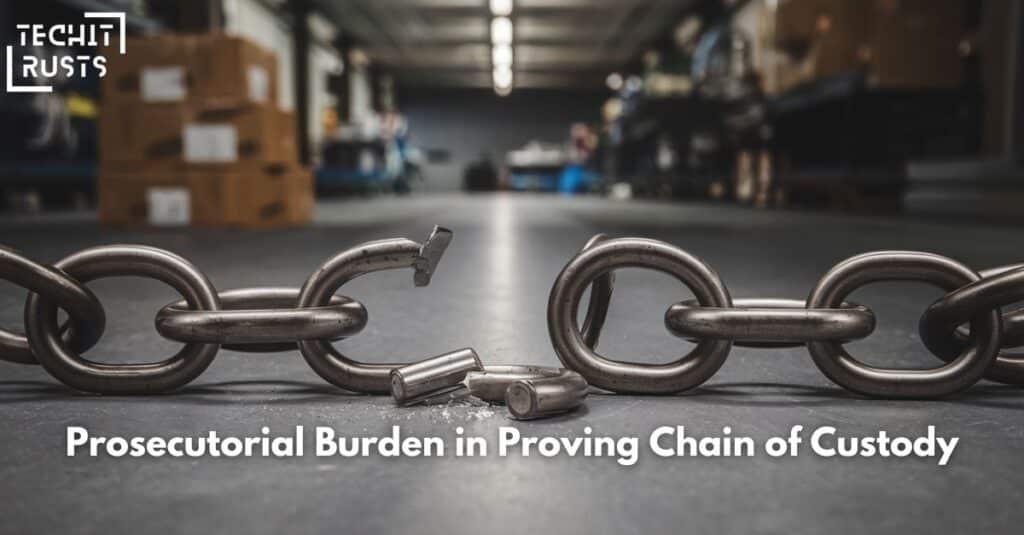In the realm of Chain of Custody New Mexico Criminal Law, the handling of evidence can make or break a case. The chain of custody is a crucial element that ensures that evidence has been collected, preserved, and presented without tampering or alteration.
In New Mexico criminal law, the importance of an unbroken chain of custody is even more pronounced, as mishandled evidence can lead to wrongful convictions, mistrials, or acquittals.
This article delves deep into the processes, challenges, and legal significance of maintaining a proper chain of custody in New Mexico’s criminal justice system, providing essential insights for legal practitioners, law enforcement, and the general public.
Introduction to Chain of Custody in New Mexico Criminal Law
The chain of custody refers to the chronological documentation that records the sequence of custody, control, transfer, and analysis of physical or digital evidence. It is a critical aspect of evidence handling in any criminal investigation process, as it helps to maintain the evidence integrity throughout the investigation and trial phases.

In New Mexico, the chain of custody is governed by strict procedures that ensure that all evidence, whether physical or digital, is properly handled and documented.
Each person who comes into contact with the evidence must be accounted for, and any gaps in the documentation can raise doubts about the authenticity of the evidence. Evidence documentation is particularly important in New Mexico, where diverse legal jurisdictions, including state, federal, and tribal laws, intersect.
Importance of Chain of Custody
Maintaining an unbroken chain of custody is essential because it helps to ensure the admissibility of evidence in court. If the chain of custody is broken, the defense can argue that the evidence has been tampered with, contaminated, or altered, which can result in the evidence being excluded from the trial.
This can significantly impact the outcome of the case, as key pieces of evidence may no longer be available to the prosecution. Furthermore, the chain of custody is crucial in maintaining the public’s trust in the criminal justice system.
If evidence is mishandled or improperly documented, it can lead to public skepticism and undermine confidence in law enforcement and the judicial process. As such, proper evidence handling is not just a procedural requirement, but a critical aspect of ensuring fairness and justice.
Legal Framework for Chain of Custody in New Mexico
The legal framework for chain of custody in New Mexico is grounded in state statutes, court rulings, and legal precedents that govern the collection, handling, and presentation of evidence.
Several key laws and regulations provide the foundation for how law enforcement and prosecutors handle evidence, particularly with regard to maintaining an unbroken chain of custody.
Key Legal Guidelines
- New Mexico Rules of Evidence (Rule 11-901) – This rule requires that all evidence must be properly authenticated before it can be admitted in court. This includes providing sufficient documentation to establish the chain of custody for the evidence.
- Federal Guidelines and Precedents – In cases where federal agencies are involved, such as the FBI or DEA, federal standards also apply. These guidelines provide additional oversight for the collection and handling of evidence, ensuring that evidence transfer protocols are followed and that the integrity of evidence is maintained.
- Case Law – Numerous court rulings in New Mexico have reinforced the importance of the chain of custody. In State v. McMullen, for example, the New Mexico Supreme Court ruled that gaps in the chain of custody could render evidence inadmissible, emphasizing the critical nature of proper documentation.
Cross-Jurisdictional Challenges
New Mexico’s unique legal landscape presents specific challenges when it comes to maintaining a proper chain of custody. The state is home to 23 Native American tribes and has a significant number of cases that involve tribal jurisdictions.
In cases where evidence is collected on tribal lands, it may need to be transferred between tribal, state, and federal authorities, complicating the process and increasing the potential for chain of custody vulnerabilities.
Responsibilities of Law Enforcement
In New Mexico, law enforcement agencies are required to follow strict evidence handling and documentation procedures to ensure that the chain of custody is maintained. This includes:
- Properly documenting the collection and storage of evidence.
- Ensuring that evidence is transferred securely and with minimal risk of tampering.
- Maintaining detailed records of who has handled the evidence at each stage of the investigation.
By adhering to these procedures, law enforcement agencies help to ensure that the evidence will be admissible in court and that the integrity of the investigation is preserved.
Key Steps in Establishing Chain of Custody

Maintaining an unbroken chain of custody involves a series of meticulous steps, each of which is essential to preserving the integrity of the evidence. These steps begin at the crime scene and continue through the trial, requiring careful documentation and handling at every stage.
Evidence Collection
The first step in establishing the chain of custody is the collection of evidence. This occurs at the crime scene, where law enforcement officers are responsible for identifying, collecting, and securing any items that may be relevant to the investigation.
- Documentation – Officers must document the time, date, and location of the evidence collection, as well as their name and badge number. Any failure to properly document the evidence collection can lead to questions about the authenticity of the evidence.
- Sealing and Labeling – After evidence is collected, it must be properly sealed in tamper-evident packaging and labeled with a unique identifier. This ensures that the evidence cannot be altered or contaminated while in transit.
Evidence Transfer
Once the evidence is collected, it must be transferred to the appropriate storage facility or forensic lab for analysis. During this transfer process, the evidence must be accompanied by detailed evidence transfer protocols that document who is taking possession of the evidence and where it is being transferred.
- Chain of Custody Log – A chain of custody log must be maintained at all times, recording the names of everyone who handles the evidence, the time and date of the transfer, and the reason for the transfer.
- Physical Security – Evidence must be transported in secure, locked containers to prevent tampering or loss during transit.
Storage and Preservation
Evidence that is not immediately analyzed must be stored in a secure facility to ensure that it remains intact and uncontaminated. In New Mexico, evidence is often stored in specialized facilities with controlled environments to prevent degradation.
- Controlled Access – Only authorized personnel are allowed to access the evidence storage facility, and any access to the facility must be documented in the chain of custody log.
- Environmental Controls – Certain types of evidence, such as biological samples or digital evidence, require specific environmental conditions to prevent degradation. For example, biological evidence may need to be stored in cold environments, while digital evidence must be stored in secure, tamper-evident systems.
Courtroom Presentation
Finally, when the evidence is presented in court, the prosecution must be able to demonstrate that the chain of custody has been properly maintained. This involves providing the court with the complete chain of custody documentation, which details every transfer, analysis, and storage action taken with the evidence.
- Prosecutorial Burden – The prosecution bears the prosecutorial burden of proving that the chain of custody is intact and that the evidence has not been tampered with. If the defense can raise doubts about the chain of custody, the court may exclude the evidence from the trial.
Importance of Documentation in Chain of Custody
The most important aspect of maintaining an unbroken chain of custody is documentation. Every individual who handles the evidence must log their actions in a chain of custody report. This report must be detailed and accurate to ensure that the evidence can be traced from the moment it is collected to the moment it is presented in court.
Elements of Chain of Custody Documentation
- Time and Date Stamps – Each transfer of evidence must be logged with an exact time and date.
- Name of the Individual Handling the Evidence – The person responsible for the transfer or storage must be identified by name, badge number, or employee ID.
- Reason for Transfer – The documentation should explain why the evidence is being transferred or analyzed at each step of the process.
- Condition of Evidence – Any changes to the condition of the evidence must be noted. For example, if a package is opened for analysis, it must be resealed and documented.
Impact on Evidence Integrity
Proper evidence documentation ensures that the evidence can be trusted in court. Any inconsistencies or gaps in the documentation can raise doubts about the authenticity of the evidence and lead to its exclusion.
For example: In a case involving DNA evidence in New Mexico, the defense successfully argued that incomplete documentation of the evidence transfer process raised questions about the integrity of the DNA sample, leading to the suppression of the evidence.
Special Considerations for Digital Evidence
Digital evidence presents unique challenges for documentation. Digital files can be easily altered or deleted, making it difficult to prove their authenticity without proper documentation.
To address this issue, law enforcement agencies in New Mexico have begun using digital evidence tracking systems that log every access, transfer, and modification to the digital file. These systems provide an additional layer of security by ensuring that all actions taken with the digital evidence are documented and verifiable.
Technological Advances in Chain of Custody

As technology continues to evolve, new tools and systems have been developed to improve the efficiency and accuracy of the chain of custody process. These technological advances are particularly important in complex cases involving large amounts of evidence or digital evidence that must be tracked across multiple jurisdictions.
Digital Evidence Tracking Systems
One of the most significant advances in chain of custody technology is the development of digital evidence tracking systems. These systems use specialized software to track the movement and handling of digital files, ensuring that every action taken with the evidence is logged and verifiable.
- Audit Trails – Digital evidence tracking systems create detailed audit trails that record every access, transfer, or modification made to the digital file. This ensures that the evidence remains unaltered throughout the investigation and trial.
- Cloud-Based Solutions – Some jurisdictions have begun using cloud-based evidence management systems that allow law enforcement agencies to store and track digital evidence securely online. These systems provide additional flexibility and ensure that evidence is accessible to authorized personnel without the risk of tampering.
Barcoding and RFID Technology
For physical evidence, barcoding and RFID (Radio Frequency Identification) technology have become increasingly common in New Mexico. These technologies help to streamline the process of tracking and documenting the movement of physical evidence.
- Barcoding – Each piece of evidence is assigned a unique barcode that can be scanned at each stage of the chain of custody. This reduces the risk of human error and ensures that the evidence is accurately tracked.
- RFID Tags – RFID tags can be attached to evidence packages to provide real-time tracking of the evidence’s location. This is particularly useful in cases involving large quantities of evidence or complex investigations with multiple agencies involved.
Blockchain for Chain of Custody
A new and emerging technology in the field of evidence management is the use of blockchain to ensure the authenticity of digital evidence. Blockchain creates a decentralized and immutable ledger that records every transaction or transfer made with the evidence.
- Immutable Records – Because blockchain is decentralized and tamper-proof, it provides an additional layer of security for evidence tracking. Any attempt to alter the chain of custody would be immediately detected.
- Courtroom Use – While still in its early stages, blockchain technology could revolutionize the way digital evidence is handled and presented in court, providing a secure and transparent method of documenting the chain of custody.
Challenges and Vulnerabilities in Maintaining Chain of Custody
Despite the best efforts of law enforcement and legal professionals, maintaining an unbroken chain of custody presents significant challenges. Several common vulnerabilities can arise during the process, which can jeopardize the integrity of the evidence.
Human Error
One of the most common challenges in maintaining the chain of custody is human error. Mistakes such as mislabeling evidence, failing to log a transfer, or improper sealing of evidence can create gaps in the chain that the defense can exploit during the trial.
- Documentation Errors – Failure to properly document each step of the evidence handling process can lead to questions about the integrity of the evidence. Even small mistakes, such as a missing signature or incorrect date, can raise doubts in the minds of the judge or jury.
- Training Issues – In some cases, law enforcement personnel may not receive adequate training on proper chain of custody procedures, leading to mistakes that can compromise the evidence.
Cross-Jurisdictional Issues
In New Mexico, cases often involve multiple law enforcement agencies, including local, state, and federal authorities. When evidence is transferred between different jurisdictions, the risk of chain of custody vulnerabilities increases.
- Inconsistent Protocols – Different agencies may have different protocols for handling and documenting evidence. This can lead to confusion and inconsistencies that the defense can challenge in court.
- Tribal Jurisdictions – Cases involving tribal lands present additional challenges, as evidence may need to be transferred between tribal and state or federal authorities. In such cases, maintaining proper documentation and ensuring that all parties follow the same procedures is critical.
Tampering and Contamination
Evidence tampering and contamination are serious concerns in any criminal investigation. If evidence is not properly sealed or stored, it can become contaminated or altered, leading to questions about its authenticity.
- Tampering – Tampering occurs when someone intentionally alters or manipulates the evidence. In some cases, this can be done to strengthen the prosecution’s case or weaken the defense. If tampering is suspected, the evidence may be excluded from the trial.
- Contamination – Contamination can occur unintentionally, particularly with biological evidence such as blood or DNA samples. Improper storage or handling can lead to cross-contamination, rendering the evidence unreliable.
Legal Implications of a Broken Chain of Custody

The legal implications of a broken chain of custody can be significant, often determining the outcome of a criminal case. When the chain of custody is broken, it raises questions about the integrity of the evidence, which can lead to the exclusion of that evidence from the trial.
Admissibility of Evidence
The most immediate consequence of a broken chain of custody is the risk that the evidence will be deemed inadmissible. If the defense can demonstrate that there are gaps or inconsistencies in the chain of custody, the court may exclude the evidence, which can severely weaken the prosecution’s case.
- Burden of Proof – The prosecution bears the burden of proof in demonstrating that the chain of custody is intact. If they cannot provide sufficient documentation to establish an unbroken chain, the defense may file a motion to suppress the evidence.
- Motion to Suppress – If the evidence is excluded, the prosecution may be forced to rely on other forms of evidence or testimony to prove their case. In some instances, this can lead to a dismissal or acquittal if the excluded evidence was critical to the case.
Impact on Prosecution and Defense
For the prosecution, proving the chain of custody is an essential part of building a case. If they cannot establish an unbroken chain, the burden of proof becomes much harder to meet. On the other hand, defense against chain of custody issues is a common strategy. By raising doubts about the integrity of the evidence, the defense can challenge the prosecution’s entire case.
Real-World Examples
One notable example comes from a case in New Mexico, where the defense successfully argued that DNA evidence should be excluded because the chain of custody was broken during transport to a forensic lab. The resulting acquittal highlighted the critical role the chain of custody plays in ensuring a fair trial.
Chain of Custody in Specific Types of Evidence
Different types of evidence require different handling protocols, each with its own chain of custody vulnerabilities.
Physical Evidence
Physical evidence—such as weapons, clothing, or drugs—requires careful handling to avoid contamination or tampering. Each item must be carefully labeled, sealed, and stored. For example, controlled substances are often weighed and photographed at the time of collection to ensure their condition is unchanged.
Biological Evidence
Biological evidence, including blood, hair, or tissue samples, must be handled with extreme care. These samples are highly susceptible to degradation and contamination, especially if not stored properly. Cold storage is often required, and every access must be logged.
Digital Evidence
Digital evidence, such as emails, phone records, or computer files, presents unique challenges. Digital files can be easily altered, so digital evidence tracking systems must be used to ensure the authenticity of the data. Access to digital evidence should be restricted, and any modifications must be documented.
Prosecutorial Burden in Proving Chain of Custody

The prosecutorial burden in proving chain of custody is a critical aspect of criminal trials. The prosecution must establish that the evidence presented in court is the same as the evidence collected during the investigation.
Standard of Proof
The standard of proof requires the prosecution to show that the chain of custody is intact “beyond a reasonable doubt.” This means that every link in the chain—every person who handled the evidence—must be accounted for.
Pretrial Hearings
Issues related to the chain of custody are often addressed in pretrial hearings, where the defense may file motions to suppress evidence based on flaws in the chain. If the prosecution cannot prove the chain is intact, the evidence may be excluded.
Expert Testimony
In some cases, expert testimony may be required to explain complex chain of custody issues to the jury. Forensic experts are often called to testify about the procedures used to collect, store, and analyze evidence, particularly in cases involving forensic evidence.
Defending Against Chain of Custody Issues in Court
Defense attorneys often focus on chain of custody issues as a strategy to weaken the prosecution’s case. This involves scrutinizing every step of the evidence-handling process to identify potential flaws.
Challenging the Evidence
One of the most effective ways to challenge the chain of custody is by highlighting gaps or inconsistencies in the documentation. For example, if there is a missing log entry or if the evidence was not properly sealed, the defense can argue that the evidence may have been tampered with.
Cross-Examination of Witnesses
During the trial, the defense may cross-examine law enforcement officers, forensic analysts, and other custodians of the evidence. By questioning these individuals, the defense can cast doubt on the integrity of the evidence.
Introducing Alternative Theories
In some cases, the defense may present alternative theories to explain how the evidence could have been mishandled or tampered with. This strategy is particularly effective when there are clear chain of custody vulnerabilities, such as multiple transfers between agencies.
Case Studies: Chain of Custody in New Mexico Courts
Chain of custody case studies from New Mexico highlight both the challenges and the successes of maintaining an unbroken chain.
Example 1: State v. Martinez
In State v. Martinez, the prosecution’s case hinged on DNA evidence. However, the defense argued that the DNA sample had been improperly stored, leading to contamination. The court ruled in favor of the defense, and the evidence was excluded.
Example 2: State v. Garcia
In State v. Garcia, the defense challenged the authenticity of digital evidence obtained from the defendant’s phone. However, the prosecution successfully proved the chain of custody using digital evidence tracking software, and the evidence was admitted.
Example 3: Federal Drug Trafficking Case
In a federal drug trafficking case involving multiple agencies, the defense claimed that the drugs had been tampered with during transport. However, the prosecution provided detailed chain of custody documentation from each agency involved, and the evidence was upheld.
Frequently Asked Questions
What is the chain of custody in criminal law?
The chain of custody refers to the process of documenting the handling and transfer of evidence to ensure that it remains authentic and unaltered.
Why is the chain of custody important in New Mexico?
The chain of custody is important in New Mexico because it ensures the admissibility of evidence in court and helps maintain the integrity of the judicial process.
What happens if the chain of custody is broken?
If the chain of custody is broken, the evidence may be excluded from the trial, which can weaken the prosecution’s case.
How do defense attorneys challenge the chain of custody?
Defense attorneys can challenge the chain of custody by highlighting gaps or inconsistencies in the documentation, cross-examining witnesses, or presenting alternative theories of tampering.
What role does technology play in maintaining the chain of custody?
Technology plays an increasingly important role in maintaining the chain of custody by providing tools for digital evidence tracking, audit trails, and secure storage systems.
Conclusion
In New Mexico criminal law, the chain of custody is crucial for maintaining evidence integrity. It ensures that evidence is properly handled, documented, and stored from collection to trial. This process helps prevent tampering, loss, or contamination of evidence, which is vital for a fair trial. A break in the chain of custody can lead to evidence being dismissed or a case being weakened.
However, maintaining a secure chain of custody can be challenging. Issues like human error, poor documentation, or lack of resources can affect the process. Law enforcement and legal teams must follow strict procedures to preserve the chain of custody. This careful handling helps protect the rights of all parties involved and supports justice in New Mexico’s criminal cases.
>>>Read Also: Understanding The Yolanda Atkinson New Jersey Lawsuit: Key Details And Potential Impact

Ashi is the site admin for “techitrusts.com” and specializes in writing within the journal category. If you need more detailed information about his background or work, feel free to ask!